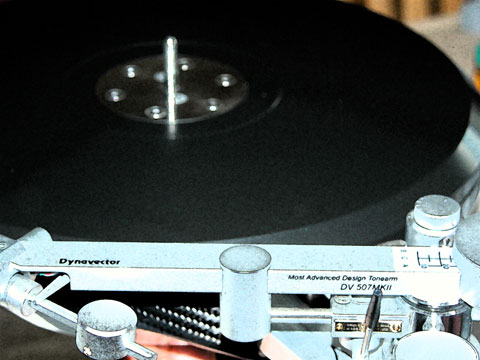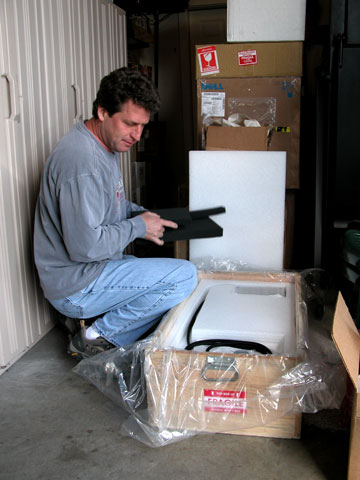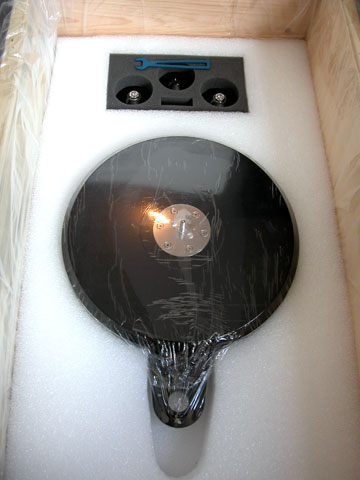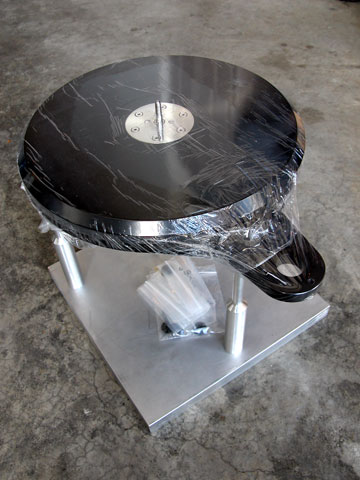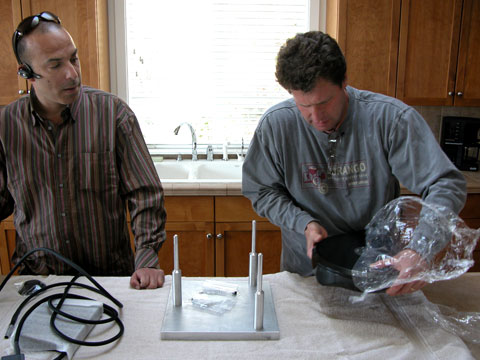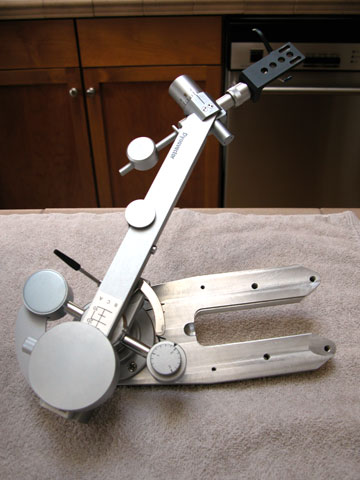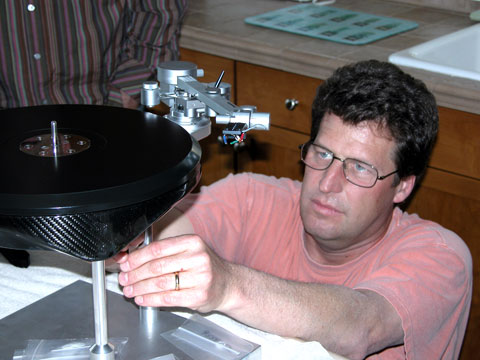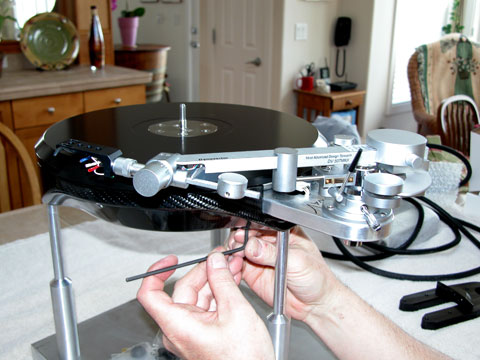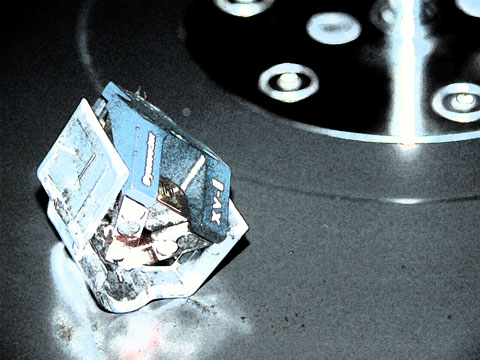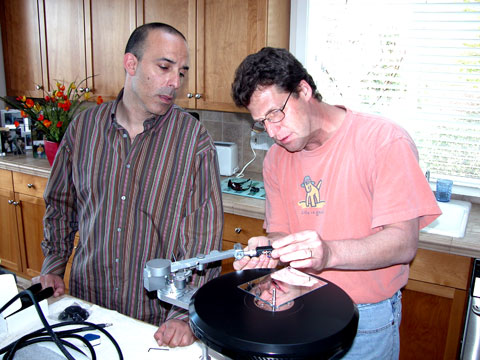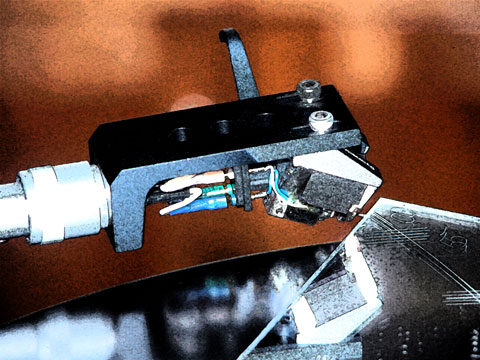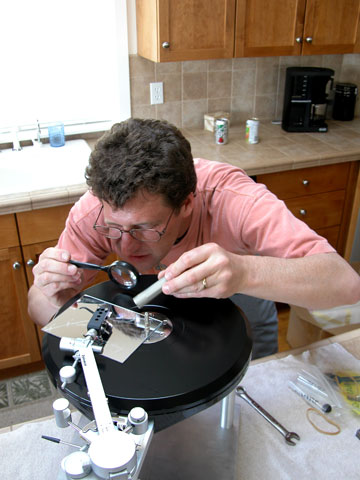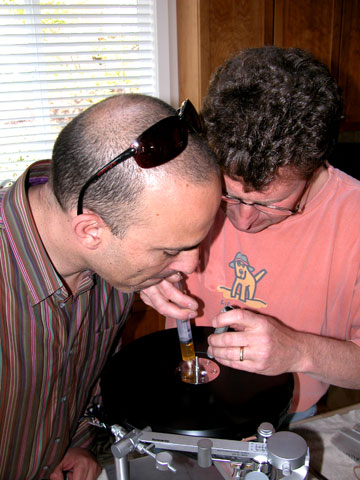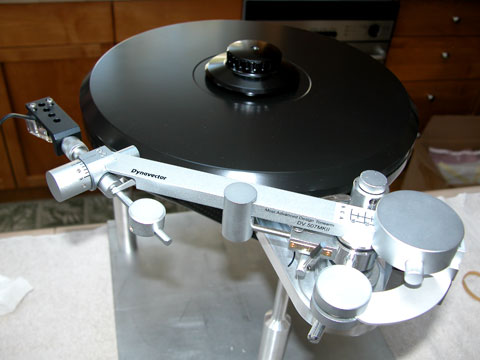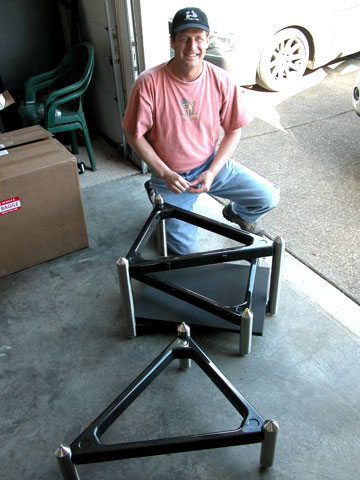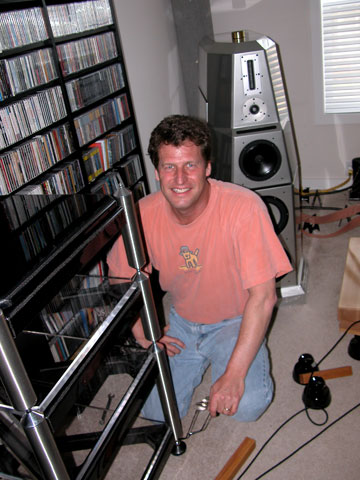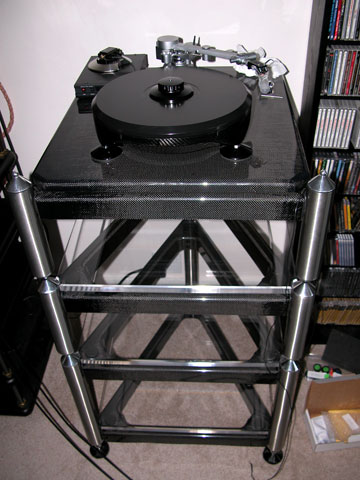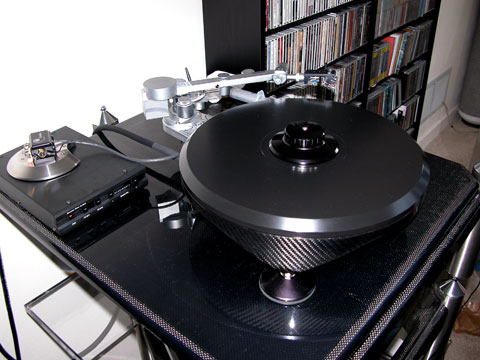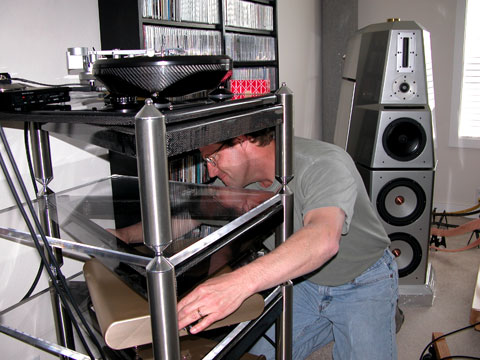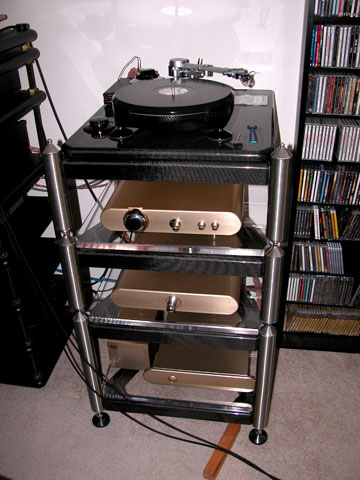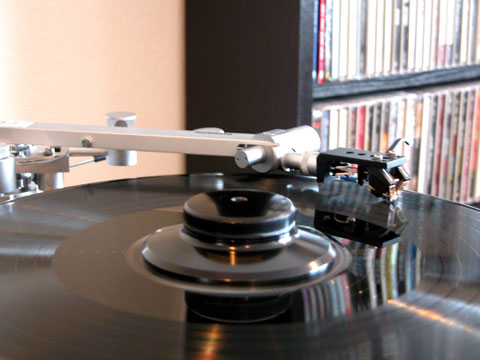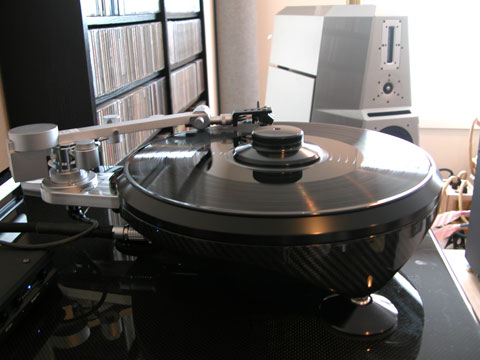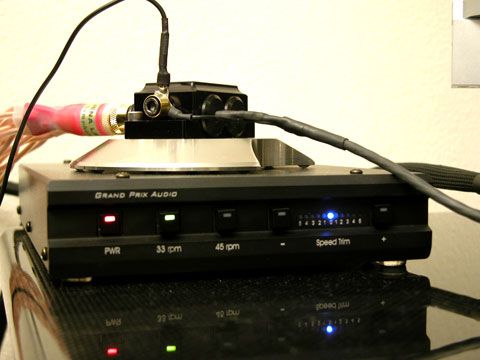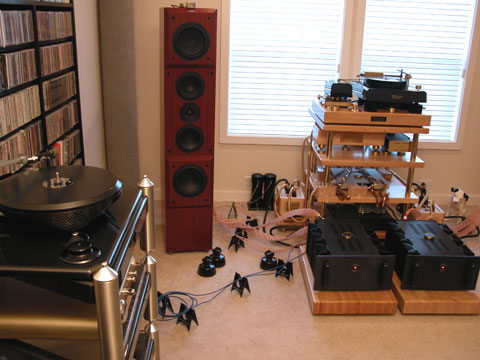|
You are reading the older HTML site
Positive Feedback
ISSUE
25
Impressions: A Photo Essay, from an Editor's Notebook, Part 2
- The
Grand Prix Audio Monaco Turntable with the Dynavector DV 507MKII Tonearm and Dynavector DRT
XV-1s MC Cartridge on the Grand Prix Audio Monaco Modular Isolation System
Just when you think you've seen and heard—if not "it all," then at least "a lot"…along comes something new. Even in the venerable world of turntables, the audio arts churn ahead, heedless of the fact that vinyl and turntables are supposed to be dead, dead, dead! Instead, we find ourselves in an ongoing new golden age of grooves, with the finest playback and some of the finest new vinyl ever. (Some of the finest new vinyl, I said—not all. Despite the reissues of some excellent work on 180 and 200 gram by the likes of Speakers Corner, Sundazed, Cisco Records, and Classic Records, some vintage collectable LPs still set the standard for LP mastering.) Unlike some, I never sold my LPs, and have kept turntables and open reel recorders around the place to keep my hearing calibrated. This helped me to recognize the possibilities of DSD and SACD immediately. Too much run-of-the-mill Red Book would have dulled my sensibilities. Back to turntables. Audiophiles—being audiophiles—have very definite notions about which turntable/tonearm/cartridge combination is "the best on the planet." This argument has been going on for years now; it's a good time-killer if you have nothing better to disagree about. Ultimately, one's choice of "the best" in turntables is like most matters of preference: a question of taste. Like "the best car" or "the finest cigar" or "the greatest wine," the answer will be highly personal. "De gustibus non disputandem," ("There's no arguing about taste.") said the Romans …and they were right. Don't think so? Go argue with a close friend about his or her choice in a spouse. "You can't possibly have married that!" Folks have ended up in Boot Hill for a lot less than that. I prefer to think of the best in turntables as a group or a community of designs. Each represents a designer's take on the best possible combination to pull musical magic out of those pesky furrows. Some do this by sheer mass in the plinth/stand; some use spring (Linn), rings (SME), or air suspension (Walker Audio), while others remain unsuspended. For materials Walker Audio uses lead and crushed marble; Teres Audio uses exotic woods; others use acrylics, aluminum, or hybridized/sandwiched materials. Pivoted tonearms have their advocates, but some integrate the pivot on the plinth while others place it on a separate tower. Linear tonearms, while more rare, have devotees who prefer its theoretically superior vector on the groove. Should clamping be used? Walker Audio, Clearaudio, SME, Basis and SOTA (among others) say yes; Linn, on the other hand, says no. We can say that the very best turntables are all generally unique combinations of design elements. The one thing they will all have in common (and in common with all fine audio components) is that "reference-grade" is going to cost you some real money. It's just a question of how much, and which synthesis touches your heart. The first rank of turntables on the list of what I've heard would include the Walker Audio Proscenium Gold Signature turntable system, the Continuum Caliburn, the Rockport System III Sirius, and the Clearaudio Master Reference system. I have another list of turntables that have excellent reputations among audio friends of mine whose sensibilities I trust, but that I haven't heard yet—the SME 30, the big Transrotor, the even bigger Basis, the Nottingham Deco, the Simon Yorke, Tim de Paravicini's La Platine E.A.R., and perhaps the Galibier, Teres Audio, and Redpoint reference models—who are certainly also in the first rank. (If I leave other contenders out, I'll probably hear about it.) Everybody's got to live somewhere, and this isn't such a bad neighborhood if you're a turntable. But there's news, vinyl lovers: I need to add another name to the list of my "in the first rank in LP playback": the Grand Prix Monaco turntable. Alvin Lloyd and company have come up with an intriguing approach to turntable playback. They've taken their strong suit in carbon fiber design and fabrication and used it to produce a carbon fiber plinth of very compact proportions and an extremely high degree of vibration damping. The platter is composed of magnesium, with a flywheel of phosphor bronze. The platter system is suspended in oil, with a direct drive brushless DC motor operating via induction. There is no direct physical contact in the horizontal plane between the drive/drive control system and the platter; the vertical plane is supported by a ceramic bearing in oil. In summary, the Grand Prix Monaco turntable is a non-suspended, computer-controlled, direct drive design, with provision for a single integrated pivoting tonearm and a record clamp. Grand Prix Audio's approach to the challenges posed by LP playback differs from most other reference turntables, being a combination of materials science and computer science. Every turntable designer faces the same set of problems with LP playback: acoustical isolation, type and linearity of the drive system, getting an LP to lie flat for proper coupling to the platter and minimization of groove artifacts, the type of tonearm system preferred, the composition and configuration of the plinth, isolation from RF/EMI, the nature of the interface between the turntable system and the phono amp/step-up transformer, and so on. Every designer or design team working on a reference grade product develops its own blend of parameters to provide a solution to the puzzle of the groove. Among the options are massive non-suspended plinths/stands vs. suspended ones; pivoting vs. linear tracking tonearms; clamping vs. vacuum hold down (or both) vs. no clamping system; direct drive vs. belt/band/string drives; and so on. Most fine turntables use belt or band drives nowadays; the question of belt slippage is well known, and requires no comment. Various approaches have been used to overcome the "on again, off again" of standard belt drives: belts, strings, cam-style toothed belts, multiple motors with strings/belts, and differing belt/band/string materials. Grand Prix Audio has chosen the demanding path of direct drive, but it's direct drive with a difference. The Monaco's drive system is controlled by a compact computer box whose digital signal processor (DSP) is dedicated via an 18 pin Lemo connector to the monitoring of platter position nearly 5000 times per second, and adjusting the direct drive magnetics accordingly. The result is a claimed unparalleled accuracy, with Grand Prix Audio asserting an extraordinary speed error of only 0.002%. This is speed accuracy that Alvin Lloyd claims is superior to the current generation of mastering lathes today. The result is an exceptional speed (and thus frequency and pitch) accuracy for LP playback. Linearity in analog playback being an extremely important thing, I just had to hear the result. The Arrival and Setup of the Grand Prix Monaco Turntable and Monaco Modular Isolation Rack System The first time that I got a chance to see and hear Alvin Lloyd's Grand Prix Monaco was at CES 2006. Jonathan Tinn featured the Grand Prix turntable and Grand Prix stands in his exceptional room with EMM Labs, darTZeel, Von Schweikert, and JENA Labs (see my CES 2006 report in PFO Issue 23 at www.positive-feedback.com/Issue23/ces06drpics.htm, and my Audio Oasis Award for that room at www.positive-feedback.com/Issue23/ces06dr.htm). I thought the turntable was extremely cool, and requested a review sample plus a Grand Prix Audio rack for maximum synergy. Alvin Lloyd was able to provide one by April, and flew in personally to set it up here at PFO Central.
Alvin Lloyd begins the uncrating of the Grand Prix Monaco turntable.
The Monaco platter and plinth in their foam packing material.
Voila! The radical Monaco out of the crate: a computer controlled direct-drive turntable with carbon fiber plinth and oil-suspended bearing, with screw-down record clamping. In this image, the Monaco is resting on its optional setup jig. Frankly, I wouldn't consider the jig to be an "option"; after having seen it in action I'd say that if you purchase the Monaco, you're really going to want to have the jig. It makes installing armboards and other tonearms much easier.
Jonathan Tinn (left) observes while Alvin Lloyd removes the protective wrap from the Monaco before returning it to the Grand Prix Audio jig.
Alvin tightens the screws on the Dynavector armboard. Installation is pretty simple if you have the jig: slide in the custom board, and toss in some torque.
Here's the Dynavector DV 507MKII tonearm attached to the Grand Prix Audio armboard, ready for insertion. The Monaco armboard for the Dynavector is nicely milled and very solid; it makes for a rock-solid foundation for the tonearm. I wasn't familiar with the Dynavector, which has an unusual design. The Dynavector web site (www.dynavector.com/products/tonearm/e_507mk2.html) describes the DV 507MKII as a "…bi-axis, inertia controlled, dynamic balance" tonearm. Certainly the dual axis with counterweighted headshell arm is unique in my experience. The Dynavector link above is a superior profile of this tonearm; I recommend that readers check it out for detailed exposition. In my opinion, this is the sort of rundown that all tonearm designers should provide for their products. A decent web site certainly makes it easy enough.
Alvin Lloyd begins the process of dialing in the Dynavector tonearm.
The Monaco's jig makes dealing with tonearm and cartridge adjustments much simpler. Throughout the process, I was impressed by the ingenuity and engineering of Grand Prix's setup system.
A fresco of the Dynavector DRT XV-1s cartridge resting on the Monaco platter. I was unfamiliar with this cartridge, which is Dynavector's reference grade design. Its output is rated at 0.3mV, the upper end of "low output," with a tracking force of 1.8 – 2.2 grams (I am set to 2.0 grams.) Compliance is listed as 10 x 10-6 cm/dyn, which is the upper end of "low compliance"; recommended loading is 30 Ohms. The XV-1 tips the scales at a healthy 13.5 grams; consideration for proper tonearm matching is called for. Naturally, the Dynavector tonearm was a pleasant union. (By the way: if all of this sounds like alien jargon, check out the terminology I explained in my review of the SOTA Millennia in PFO Issue 22 at www.positive-feedback.com/Issue22/sota_millennia.htm. It covers the basics.) For more on the XV-1s from Dynavector's exemplary web site, go to www.dynavector.com/products/cart/e_xv1s.html.
While Jonathan looks on, Alvin prepares to align the XV-1s.
A fresco of the Dynavector on a Wally Tractor at the start of the alignment process; for more on the Tractor, see the Wally site at www.simplyblack.net/WVC/wally_start.html.
"Dr. Alvin" at work, noodging in the XV-1s. Getting a cartridge just right takes time.
Once the XV-1s was right, the time had come to load the oil for the platter. This is done directly through some access holes in the platter itself.
The finished product: Monaco and Dynavector, ready for liftoff! Note the screw-down record clamp in place on the platter. Tonearm junkies, take note: the Monaco only accommodates one tonearm at a time.
With the turntable done, it was time for Alvin to assemble the Grand Prix Audio Monaco Modular Rack for the Monaco turntable and related electronics. The Grand Prix Audio Monaco Modular racks are remarkable, being composed of very light carbon fiber epoxy frames and aluminum and stainless steel supports that can be filled with lead pellets for mass. For this review, we skipped the lead pellets.
Alvin working on the assembly of the Grand Prix Audio rack in my listening room. We removed my old trusty-rusty Target turntable stand mit Vibraplane, and put the Monaco Modular system in place. For this review, we used a top shelf of carbon fiber (which is an optional upgrade in that system) as the home base for the Monaco turntable. The other shelves for the Wavac preamp and phono preamp were the standard acrylic, as you can see above. In the background is one of the magnificent Von Schweikert VR-9 SE loudspeakers.
Once the Monaco Modulation Isolation System was completed, the Monaco turntable was placed on the top carbon fiber shelf. The incredibly compact footprint of this turntable is obvious — little larger than a 12" LP. In the left rear corner of the top shelf the Grand Prix Audio DSP computer which controls the direct drive system can be seen; sitting on top of that unit is a Cardas cable block, which converts DIN connection to standard RCAs. This allows you to use your favorite RCA cables between the Monaco and your phono amp. We used JENA Labs for that connection.
The Grand Prix Audio rack from a different angle, waiting for the rest of the gear. Very sharp looking, and (as it turned out) excellent sounding, too.
This view lets you see the carbon fiber of the Monaco's plinth, and also shows the DIN output cable attached to the Cardas block on top of the DSP motor controller. Radically cool!
Alvin Lloyd placing the Wavac LCR-X2 phono amplifier on a shelf; this man worked hard!
The completed installation: From top to bottom, the Grand Prix Monaco, the Wavac PR-T1 preamplifier, the Wavac LCR-X2 phono amplifier, and the Wavac TR-B1 transformer for the LCR-X2 (left) with its PS-X2 power supply (right). The Wavac gear is all milled out of solid aluminum blocks—quite a load, Maynard!
This is a close-up of the innovative Sorbothane ring with plastic protector that Alvin places on the platter. When you use the screw-down record clamp, it presses the LP onto this ring for a firm, safe contact between your record and the underlying platter/plinth. The hex screws cover the access holes for the oil chamber for the bearing.
The Monaco/Dynavector system in action. Here you see the screw-down record clamp holding the LP in place. Alvin uses an interesting system to get the clamping right for each album: he tightens down the clamp, gently rapping with his index finger's middle knuckle until the hollow sound becomes a tight and solid thunk, indicating that the LP has made proper contact with the platter. Then he backs it off about a quarter turn. Unique stuff. We left the Monaco spinning overnight to put some time on the bearing, and called it a day.
The compact and beautiful Monaco turntable—bring on those LPs! Loose Notes and Listening Impressions When Alvin Lloyd, Jonathan Tinn and I started listening on Saturday, the day after the setup was complete, I wasn't sure what to expect. I know that Jonathan was excited about the capabilities of the Monaco/Dynavector combination, and my first take of this table at CES 2006 had been very promising, but show conditions are show conditions. Operations were simple enough; the Monaco is easy to use. Firing up the table is done by pushing the power button on the DSP controller (which can be left on), and then pressing either the 33 or 45 button to set the speed. Within 2-3 revs of the direct drive system, you're up to speed. You'll know when the DSP has locked on 33.3 or 45 RPM: the blue "spot on" LED comes on at the "0" position to indicate that you're running at precisely at the proper platter speed. (See image below.) This control can also be used to plus or minus the platter speed by a smidgeon in precise increments for pitch control. This is a very sensitive drive system. The DSP would lose the blue LED any time the platter or an LP was touched sufficiently to affect the rotation. An instant later, the LED would come on again, indicating that we were back at proper speed.
The Grand Prix Audio Monaco Turntable computer controller; on top is the Cardas block, grounding cable, and JENA Labs interconnect. And then the stylus descended on some great Sinatra…and terrific things started to happen. From the first notes, I knew that Alvin had hit a home run with the Monaco. Jonathan was grinning to beat the band, and I relaxed almost immediately. In just a few moments I was sure: this was the real thing. When you're nodding, tapping your toe, and closing your eyes, all's well. We went through a number of LPs that day …among these were The Weavers Live at Carnegie Hall on 45s, Crosby, Stills and Nash/Young on Classic Records reissues, Ella Fitzgerald Sings Songs from Let No Man Write My Epitaph, Cal Tjader's La Onda Va Bien on 45, Analogue Production's reissue of Fiddle Faddle on 180 gram, Brubeck's Time Out on Classic Records 45, and Dorati's performance of The Firebird reissued by Classic Records, likewise at 45 RPM. Some Beatles on MoFi. Some David Crosby on 200 gram 33.3 RPM. And so on. You know how it goes when a source component—turntable/tonearm/cartridge, SACD player, whatever—is doing things right. You go from recording to recording, enjoying the ride, taking in the music, finding new things in old friends, and trying new recordings just for fun. That's what Alvin, Jonathan and I did that day, all day long. Which is to say: "A good time was had by all!" I certainly couldn't fault the Monaco; it ran silently, smoothly, and was simplicity itself to operate. The Monaco Modular Isolation System provided an exceptional foundation for the Monaco turntable; there was simply no comparison to the Target turntable stand that it replaced (which has now been permanently retired, and which I hope to replace with the Grand Prix rack), and whose qualities I know quite well. The music that I was hearing from the Grand Prix Audio system was well ahead of any turntable that I had heard on the Target: smooth and coherent, with a natural ease. It sounded like music. The Dynavector was a new experience; I haven't used a bi-axis tonearm before. The action of the cueing lever is very good, generally on par with the SME's that I've tried, though not as dampened in cueing as my Linn Ekos. The sub-arm of the Dynavector handled well, allowing easy placement of the stylus. I got used to its feel pretty quickly. The Neodymium magnetic damping system seemed to work well, and also provides a magnetic tonearm rest, holding the Dynavector firmly in place. Controls for tracking force and anti-skate are well placed and easy to access. On the other hand, adjusting the VTA is a bit more challenging, requiring access to the rearward side of the tonearm mount. I could wish that there was some sort of scale for adjusting the VTA here, but I didn't find one. Many LP listeners don't bother much (or at all) with adjusting their VTA, quite often because their tonearms/turntables make it hard to do. Of course it's true that some folks just don't care. This is a pity, since my Walker Audio Proscenium Gold Signature 'table has taught me how much more can be retrieved from the grooves when you take the time to get VTA right. I've been listening to the Monaco/Dynavector combination for about seven weeks now, and it will be leaving very soon. I'm going to be very sorry to see it go. The impression it's left with me is of a turntable that has that crucial quality: it connects me emotionally to the music. Yes, soundstaging and imaging are excellent; yes, it's dynamic; yes, there's texture and nuance to burn. But it's more than that: the Monaco/Dynavector DV 507 MkII/Dynavector XV-1s combination is rich, yet detailed in its presentation. I heard a fusion of lushness and harmonic rightness that's always a sign that somebody's getting it right. "Synergy" is written all over this combo; Dynavector clearly likes teaming up with Grand Prix Audio. I'll have to admit that I didn't spend much time evaluating or note-taking; I just leaned back and took in the music. And this doesn't happen to me with just any turntable. There are more than just a few yawners out there—this isn't one of them. There's no reason to multiply words here: I think that Grand Prix Audio is really on to something important with their Monaco turntable and isolation system. In my estimation, the Grand Prix Audio Monaco turntable and Monaco Modular Isolation Systems definitely belongs in the first rank of turntables and isolation stands. If you are looking for a turntable with a compact footprint that will give you truly world-class performance, and have a budget that will float in this price range, you owe it to yourself to audition the Monaco(s). I think you're in for an extraordinary delight. Since I judge this system to be in the "first rank" of turntables, I therefore give the combination of the Grand Prix Audio Monaco turntable/Dynavector DV 507 MkII/Dynavector XV-1s on the Grand Prix Audio Monaco Modular Isolation System a Ye Olde Editor's "Highest Recommendation!"
The Grand Prix Audio Monaco turntable and Monaco Modular Isolation System (left foreground) across the valley from the Walker Audio Proscenium Gold Signature turntable system and Prologue Rack; a pair of Lamm 1.2 mono's on Walker Audio Prologue amp stands and the Nova Rendition II's round things out, while Nipper looks on from the corner….
The
Grand Prix Audio Monaco Turntable
Dynavector DV 507MK II tonearm
Dynavector XV-1 MC cartridge Manufacturers
Grand
Prix Audio
Dynavector (USA Distributor)
|

